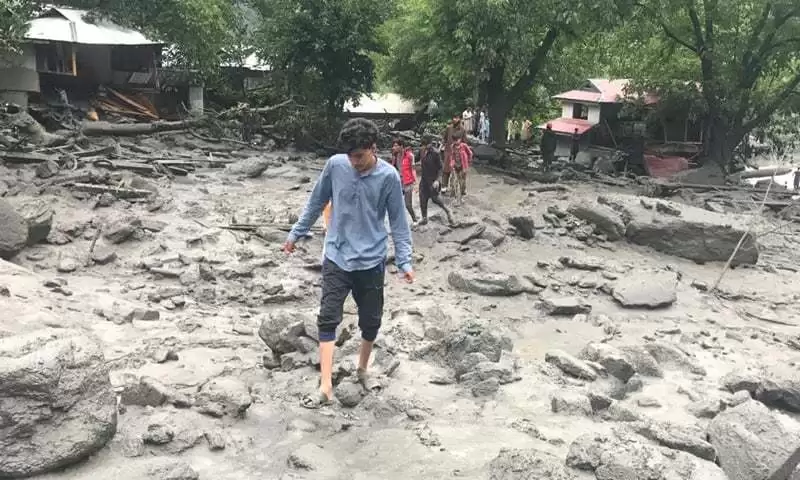Lives Lost as Cloudburst Hits Muzaffarabad
Heavy monsoon rains and a powerful cloudburst have wreaked havoc in parts of Azad Jammu and Kashmir (AJK) and Gilgit-Baltistan (GB), causing deadly flash floods and landslides. Just days earlier, the National Disaster Management Authority had issued a flood alert for these regions, warning of heavy rains and potential landslides.
In Naseerabad Tehsil of Muzaffarabad, a single family lost six members when a sudden cloudburst unleashed torrents of water through the area. Local officials confirmed that rescue teams reached the scene, but all six victims had died before they could be evacuated.
The intense rainfall, continuing for hours, swelled rivers and streams across AJK. Villages were cut off, roads were blocked by debris, and electricity and communication lines were disrupted.
Rivers Overflow, Schools Closed in Bagh District
In Bagh District, torrential rains pushed rivers and streams to dangerous levels. The Bhambher stream in Samahni surged to a high flood stage. A tourist vehicle was swept away by the current, but all passengers were rescued in time.
Fearing further danger, the Deputy Commissioner of Bagh announced the closure of all educational institutions for a day. Authorities in Jhelum Valley, Hattian Bala, Neelum Valley, and other areas also reported an unusual rise in water flow, warning residents to stay away from riverbanks.
Gilgit-Baltistan: Landslides and Glacial Melting Worsen Crisis
In Gilgit-Baltistan, the combination of monsoon rains and unstable mountain slopes has proved devastating.
In Ghizer District, a landslide killed three people and left three others missing. In Diamer, a brother and sister drowned after being swept away by a flood wave. On Babusar Road, another landslide injured a child.
Meanwhile, in Hunza, the melting of the Shishper Glacier has accelerated erosion along the banks of the Hasanabad stream. Local authorities issued evacuation notices for at-risk houses, fearing collapse into the rushing water.
Crops and Infrastructure Damaged
The floods and landslides have not only taken lives but also caused extensive damage to crops, houses, schools, and agricultural land. Initial reports suggest dozens of homes have been destroyed or severely damaged, and standing crops in low-lying areas have been washed away.
The Gilgit-Baltistan government has declared an emergency in the affected districts. Residents in flood-prone zones have been instructed to vacate low-lying areas and move to safer ground.
Mass Evacuations in Khyber Pakhtunkhwa
In Mansehra district of Khyber Pakhtunkhwa, sudden flooding in a stream near the Siran Valley Family Park led to the evacuation of around 1,300 tourists. According to the District Emergency Officer, the park was unusually crowded due to the holiday season, and the evacuation was carried out swiftly to prevent casualties.
Further north, in Upper Kohistan, rising water levels in the Indus River prompted the closure of the Karakoram Highway to all traffic. Authorities urged residents to take precautions and avoid going near rivers and streams.
Monsoon Patterns and Regional Vulnerability
The current wave of heavy rainfall is part of Pakistan’s July–September monsoon season, which regularly brings flooding to mountainous regions like AJK and GB. However, meteorologists note that cloudbursts — extremely intense, short-duration rainfalls — have become more frequent in recent years.
Experts attribute this partly to climate change, which is altering weather patterns and increasing glacier melt rates. In mountain regions, this combination often triggers both flash floods and landslides.
Emergency Response Underway
Rescue and relief teams, including personnel from the Pakistan Army, are on standby in both AJK and GB. Temporary shelters are being set up for displaced families. Local governments have appealed for donations of food, blankets, and medical supplies.
Authorities are monitoring weather forecasts closely, with more rain expected in the coming days. Residents have been told to remain alert and comply with evacuation orders.
For many communities in these rugged mountain valleys, the coming week will be critical — both for survival and for the start of a long recovery from yet another monsoon disaster.















